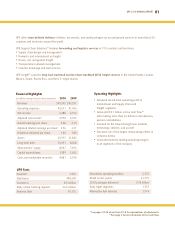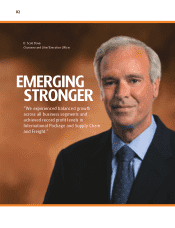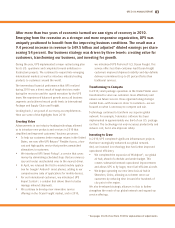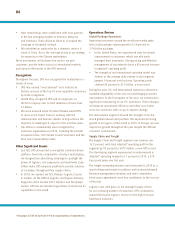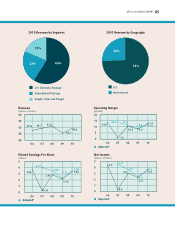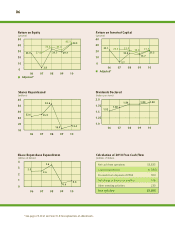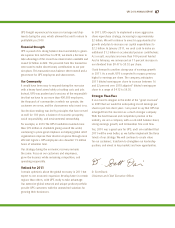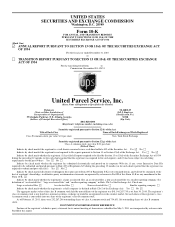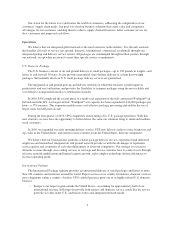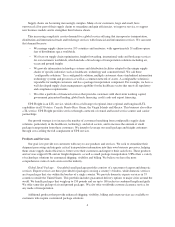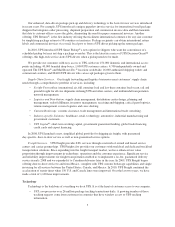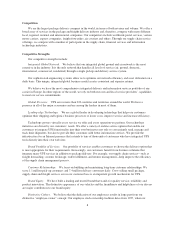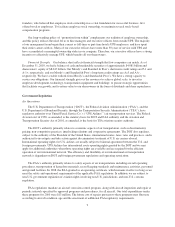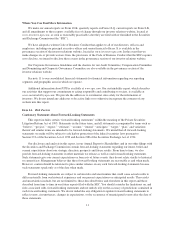UPS 2010 Annual Report Download - page 13
Download and view the complete annual report
Please find page 13 of the 2010 UPS annual report below. You can navigate through the pages in the report by either clicking on the pages listed below, or by using the keyword search tool below to find specific information within the annual report.PART I
Item 1. Business
Overview
United Parcel Service, Inc. (“UPS”) is the world’s largest package delivery company, a leader in the U.S.
less-than-truckload industry, and a global leader in supply chain management. We were founded in 1907 as a
private messenger and delivery service in Seattle, Washington. Today, we deliver packages each business day for
1.1 million shipping customers to 7.4 million consignees in over 220 countries and territories. In 2010, we
delivered an average of 15.6 million pieces per day worldwide, or a total of 3.94 billion packages. Total revenue
in 2010 was $49.5 billion.
Our primary business is the time-definite delivery of packages and documents worldwide. The UPS service
portfolio also includes global supply chain services and less-than-truckload transportation, primarily in the
United States. We report our operations in three segments: U.S. Domestic Package operations, International
Package operations, and Supply Chain & Freight operations.
• U.S. Domestic Package operations include the time-definite delivery of letters, documents, and
packages throughout the United States.
• International Package operations encompass delivery of letters, documents and packages to more than
220 countries and territories worldwide, including shipments wholly outside the United States, as well
as shipments from or to the United States with another country as the destination or origin point.
• Supply Chain & Freight is comprised of our forwarding and logistics operations, UPS Freight, and
other related businesses. Our forwarding and logistics business provides services in more than 195
countries and territories worldwide, and includes supply chain design and management, freight
distribution, customs brokerage, mail and consulting services. UPS Freight offers a variety of less-than-
truckload (“LTL”) and truckload (“TL”) services to customers in North America. Other business units
within this segment include Mail Boxes Etc.®(the franchisor of Mail Boxes Etc.®and The UPS
Store®) and UPS Capital®.
Transportation and Infrastructure. We operate a ground fleet of approximately 99,800 vehicles, which
reaches all business and residential zip codes in the contiguous U.S. We also operate an air fleet of 527 aircraft,
and we are one of the largest airlines in the world. Our primary air hub is in Louisville, Kentucky. Regional air
hubs are located in Hartford, Connecticut; Ontario, California; Philadelphia, Pennsylvania; and Rockford,
Illinois. Our largest international air hub is in Cologne, Germany, with other regional international hubs in
Miami, Florida; Canada; Hong Kong; Singapore; Taiwan; and China.
We operate a global transportation infrastructure and offer a comprehensive portfolio of services. We
support these services with advanced operational and customer-facing technology. Our supply chain solutions
enable customers’ inventory to move more effectively. As a consequence, they can concentrate on their own core
competencies.
Outlook. Mixed economic results in 2010, combined with improving economic forecasts as the year
ended, lead us to believe that the following trends will allow us to continue to grow our business over the long-
term:
• We expect the economic recovery to continue at a modest pace in 2011. Global economies continue to
expand at less than historical trends. The sovereign debt crisis that plagued Europe in 2010 will
continue to be an area of concern in 2011.
• Just-in-time inventory management, increased use of the Internet for ordering goods, and
direct-to-consumer business models require transportation services to be effective.
• Outsourcing supply chain management is becoming more prevalent, as customers increasingly view
effective management of their supply chains as a strategic advantage.
1


